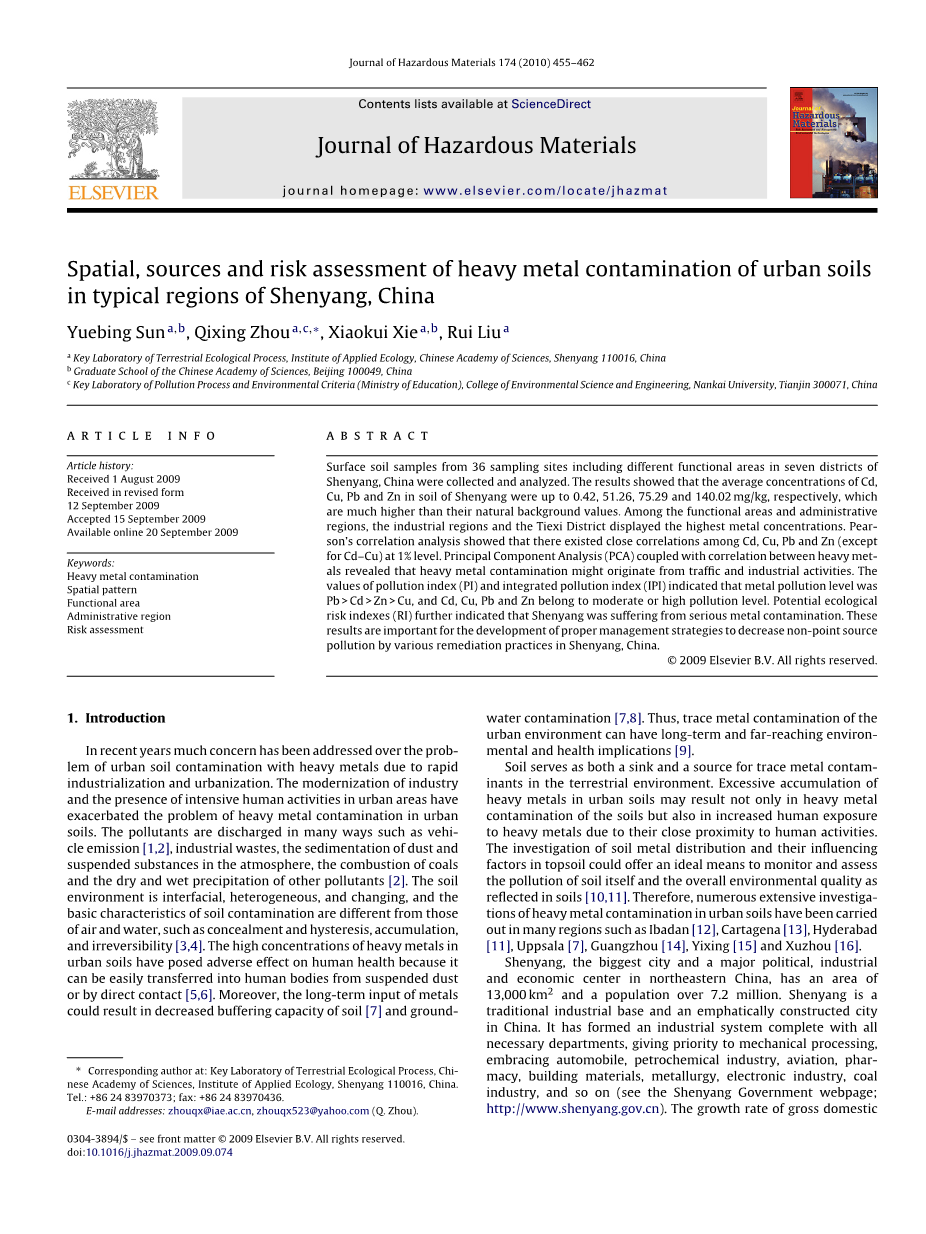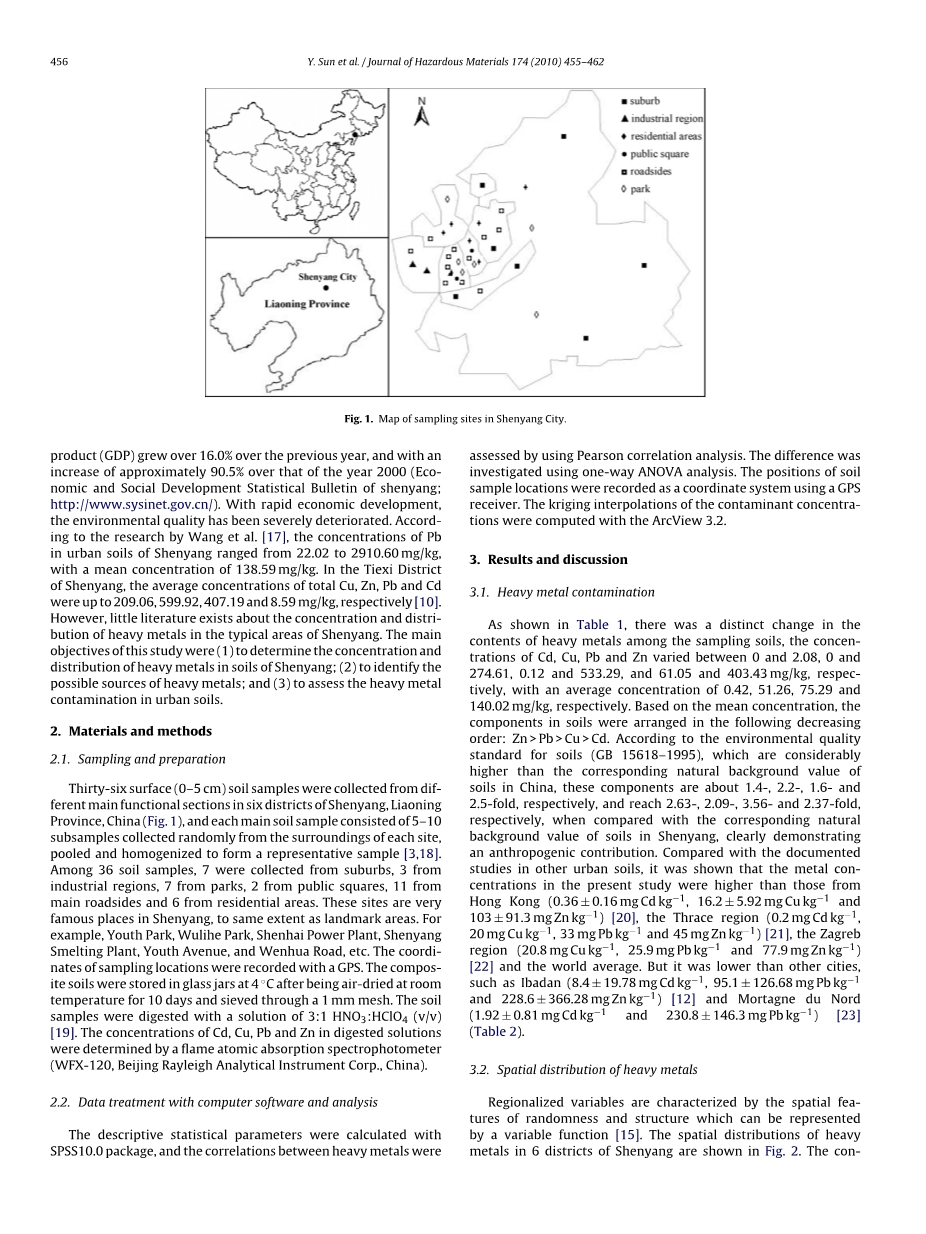中国沈阳地区城市土地重金属污染的范围、原因和风险评估
a中国沈阳110016中国科学院应用生态研究所陆地生态过程的重点实验室
b中国北京100049中国科学院研究生院
c中国天津300071重点实验室的污染过程和环境标准(教育部)、南开大学环境科学与工程学院。
文章信息文章历史:
2009年8月1日收到2
009年9月12日收到修改形式
2009年9月15日被接受
2009年9月20日被发到网上
关键词:重金属污染的空间模式 功能区域 行政区 风险评估
摘要:本论文收集和分析了来自中国沈阳7个地区不同功能区域的36个抽样点的表层土壤样品。结果表明,沈阳地区土壤中的铬、铜、铅和锌的平均浓度分别是0.42,51.26,75.29和140.02毫克/公斤,在功能区与行政区是远远高于其自然背景值 。在功能区与行政区区域,工业区和铁西区显示的是最高的金属浓度。皮尔森相关分析表明,镉、铜、铅、锌之间存在密切的相关性在1%水平上。主成分分析再加上重金属含量之间的相关性发现重金属污染可能来自交通和工业活动。这个污染指数(PI)和综合污染指数(IPI)表明金属污染水平铅>镉>铜,镉、铜、铅、锌属中等或高污染水平。潜在生态风险指数(国际扶轮)进一步指出,沈阳遭受严重的金属污染。这些结果对中国沈阳减少非点源的管理策略和侮辱的各种补救措施的发展有重要的影响 。 2009 Elsevier公司保留所有权利
引言:近年来,随着工业化和城市化进程的加快,城市土壤重金属污染问题得到了大量关注。工业现代化和城市密集的人类活动的存在加剧了城市土壤重金属污染问题。污染物是在许多方面,如车辆排放[1,2],工业废物排放,大气中的灰尘和悬浮物沉降,煤的燃烧和其他污染物的干湿沉降。土壤环境是界面、非均质、变化的,土壤污染的基本特征与大气和水体的基本特征不同,以及土壤污染的基本特征不同于空气和水,如隐蔽性和滞后性,积累,和不可逆性[3,4]。城市土壤中重金属浓度高造成对人体健康的不良影响是因为它可以很容易地转移到悬浮尘埃人体或通过直接接触[5,6]。此外,金属的长期输入可能会导致土壤的缓冲能力下降[ 7 ]和地面—
水污染[7,8]。因此,微量金属污染的城市环境,可以有长期和深远的环境和健康影响[ 9 ]。土壤作为一个在陆地环境中的接收器和一个源。重金属在城市土壤中的过度积累,可能不仅会导致在土壤中的重金属污染,也由于其接近于人类活动增加了人类暴露于重金属环境的几率。土壤重金属分布情况及土壤影响因素的调查对土壤本身和整体环境质量进行检测并作为反映土壤污染评价[10,11]的理想手段。因此,伊巴丹13、卡塔赫纳11、乌普萨拉、广州、宜兴、徐州[ 14 ]、海得拉巴[ ]、[ ]、[ ]、[ 12 ]、[ [ ]、[ 16 ]、[ 15 ]、[ [ 7 ] ]对城市土壤中的重金属污染进行了大量广泛的调查。沈阳是最大的城市和在中国东北的政治、工业和经济中心,具有13000km2面积和超过720万的人口。沈阳是我国传统的工业基地和重点建设的城市。它已经形成了一个完整的工业体系和具有所有必要的部门,优先考虑机械加工,包括汽车、石化、航空、医药、建材、冶金、电子工业、煤炭工业,等等(见沈阳政府网页;HTTP:/ / www.shenyang。cn)
图1。沈阳市采样点图。
product (GDP) grew over 16.0% over the previous year, and with an increase of approximately 90.5% over that of the year 2000 (Economic and Social Development Statistical Bulletin of shenyang; http://www.sysinet.gov.cn/). With rapid economic development, the environmental quality has been severely deteriorated. According to the research by Wang et al. [17], the concentrations of Pb in urban soils of Shenyang ranged from 22.02 to 2910.60 mg/kg, with a mean concentration of 138.59 mg/kg. In the Tiexi District of Shenyang, the average concentrations of total Cu, Zn, Pb and Cd were up to 209.06, 599.92, 407.19 and 8.59 mg/kg, respectively [10]. However, little literature exists about the concentration and distribution of heavy metals in the typical areas of Shenyang. The main objectives of this study were (1) to determine the concentration and distribution of heavy metals in soils of Shenyang; (2) to identify the possible sources of heavy metals; and (3) to assess the heavy metal contamination in urban soils
产品(GDP)增长了16%,比前一年2000年,有约90.5%以上的年增长(经济和社会发展统计公报沈阳;HTTP:/ / www.sysinet。cn /)。随着经济的快速发展,环境质量已严重恶化。根据王等人的研究。[ 17 ]沈阳市区土壤中铅浓度为22.02~2910.60毫克/千克,平均浓度为138.59毫克/千克。在铁西沈阳区,总铜,锌,铅,镉的平均浓度分别为209.06,599.92,407.19和8.59毫克/千克[ 10 ]。然而,在沈阳的典型地区很少有文献存在的浓度和分布。本研究的主要目标是(1)确定沈阳土壤中重金属的浓度和分布;(2)确定可能的重金属来源(3),评估在城市土壤中的重金属污染
2材料与方法
2.1. Sampling and preparation
2.1取样和制备
Thirty-six surface (0–5 cm) soil samples were collected from differentmainfunctional sections in six districts of Shenyang, Liaoning Province, China (Fig. 1), and each main soil sample consisted of 5–10 subsamples collected randomly from the surroundings of each site, pooled and homogenized to form a representative sample [3,18]. Among 36 soil samples, 7 were collected from suburbs, 3 from industrial regions, 7 from parks, 2 from public squares, 11 from main roadsides and 6 from residential areas. These sites are very famous places in Shenyang, to same extent as landmark areas. For example, Youth Park, Wulihe Park, Shenhai Power Plant, Shenyang Smelting Plant, Youth Avenue, and Wenhua Road, etc. The coordinates of sampling locations were recorded with a GPS. The composite soils were stored in glass jars at 4 ◦C after being air-dried at room temperature for 10 days and sieved through a 1mmmesh. The soil samples were digested with a solution of 3:1 HNO3:HClO4 (v/v) [19]. The concentrations of Cd, Cu, Pb and Zn in digested solutions were determined by a flame atomic absorption spectrophotometer (WFX-120, Beijing Rayleigh Analytical Instrument Corp., China).
36种土壤样品采自中国辽宁省沈阳市的不同功能区(图1)。每个主要的土壤样本抽取每种土壤环境种包括5–10个子样本,混合和均质化形成一个具有代表性的样本[ 3,18 ]。36个土壤样本中,7个来自郊区,3个来自工业区、7个来自公园、2个来自广场、11个来自主路旁和6个来自住宅区。这些网点是非常有名的地方,是在沈阳具有里程碑意义的地区。例如,青年公园,五里河公园、沈海热电厂、沈阳冶炼厂、青年大街和文化路等的采样位置的坐标与GPS记录。复合土壤储存在玻璃瓶中置于在4◦C空气室温干燥10天,过1mmmesh后。土壤样品用一个3:1的 HNO3:高氯酸(v/v)消化[ 19 ]。用火焰原子吸收分光光度计测定了消化溶液中镉、铜、铅、锌的含量(wfx-120、北京瑞利分析仪器公司,中国)。
2.2。计算机软件的数据处理与分析
2 . 2
The descriptive statistical parameters were calculated with SPSS10.0 package, and the correlations between heavy metals were assessed by using Pearson correlation analysis. The difference was investigated using one-way ANOVA analysis. The positions of soil sample locations were recorded as a coordinate system using a GPS receiver. The kriging interpolations of the contaminant concentrations were computed with the ArcView 3.2.
用SPSS10.0软件包进行描述性的统计参数,和重金属之间的相关性采用皮尔森相关分析评估。采用单因素方差分析法对差异进行了分析。土壤样品的位置被记录为一个坐标系统,使用全球定位系统接收器。用克里金插值的污染物浓度与ArcView 3.2计算。
3。结果与讨论
3 结果与讨论
3.1。重金属污染
As shown in Table 1, there was a distinct change in the contents of heavy metals among the sampling soils, the concentrations of Cd, Cu, Pb and Zn varied between 0 and 2.08, 0 and 274.61, 0.12 and 533.29, and 61.05 and 403.43 mg/kg, respectively, with an average concentration of 0.42, 51.26, 75.29 and 140.02 mg/kg, respectively. Based on the mean concentration, the components in soils were arranged in the following decreasing order: Zn gt; Pb gt; Cu gt; Cd. According to the environmental quality standard for soils (GB 15618–1995), which are considerably higher than the corresponding natural background value of soils in China, these components are about 1.4-, 2.2-, 1.6- and 2.5-fold, respectively, and reach 2.63-, 2.09-, 3.56- and 2.37-fold, respectively, when compared with the corresp
剩余内容已隐藏,支付完成后下载完整资料
英语原文共 8 页,剩余内容已隐藏,支付完成后下载完整资料
资料编号:[286676],资料为PDF文档或Word文档,PDF文档可免费转换为Word
课题毕业论文、外文翻译、任务书、文献综述、开题报告、程序设计、图纸设计等资料可联系客服协助查找。




